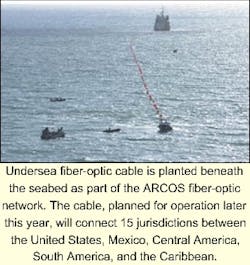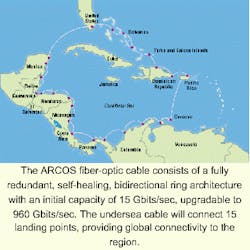ARCOS undersea cable targets Latin American carriers
By ROBERT PEASE
The ARCOS undersea fiber-optic cable that landed in North Miami Beach last April will provide global high-speed bandwidth connectivity to 200 million people in the Americas. The cable is the brainchild of New World Network (Miami), a carrier's carrier. The 8,600-km ring network, co-owned by 28 carriers throughout the region, will link the United States with the Bahamas, Turks and Caicos, the Dominican Republic, Puerto Rico, Curacao, Venezuela, Colombia, Panama, Costa Rica, Nicaragua, Honduras, Guatemala, Belize, and Mexico.
According to New World Network, a surging telecommunications market in Latin America and increasing demand for faster, more reliable connections presents enormous opportunity in the region for telecom companies. The ARCOS cable will offer 15 Gbits/sec of fully redundant, bidirectional capacity with a upgradable design capacity of 960 Gbits/sec.
"Interconnecting 15 countries in the Caribbean and the Americas is very important for the Latin American re-gion," says Macarena Gomez, marketing manager at New World Networks. "It will dramatically increase the regional infrastructure while reducing prices. The ARCOS network will also interconnect with the rest of South America through other systems and help de-monopolize the telecommunications arena usually 'managed' by the incumbents and the large U.S. carriers."Additionally, ARCOS will provide access to and from the region via the Miami landing point, providing interconnection with other worldwide cable systems. Thus far, says Gomez, there is no other submarine cable system in the region capable of providing the same level of availability to so many locations. Total cost of the initial ring system is approximately $450 million.
The ARCOS cable network was born of New World Network's strong desire to interconnect the largely underserved regions of the Caribbean and the Americas with fiber connectivity. As demand for speed and reliability increased, the company's founders and management team designed plans for a futureproof, multigigabit undersea system to meet current and future needs for bandwidth in the region.
The idea for ARCOS was spawned in 1998 and led to the formation of a management team that, together with a group of telecommunications companies, contracted for the construction of the cable. New World Network owns approximately 86.5% of ARCOS. Among the co-owners are such global companies as GTE (Dallas), MCI Worldcom Inc. (Jackson, MS), and Cable & Wireless (Vienna, VA) as well as regional carriers like Avantel, Cantv, and Codetel.
The unique ownership structure combines the advantages of an independently owned company and the benefits of strategic partnerships with local carriers that provide landing rights, backhaul, and interconnection to local networks. This hybrid ownership gives the co-owners many advantages, including timeliness in decision making, contract execution, lower construction times, and the virtual elimination of up-front customer capital requirements and capacity forecasting risks. Carrier participation also enables the ease of landing rights, backhaul, local network interconnection, and planning insight."This is highly advantageous to ARCOS as it allows the integration of its service offering into existing networks," says Gomez. "Furthermore, it creates a barrier to entry for other cable operators entering the region if ARCOS is already the preferred system of the incumbent operators."
In June 2000, New World Network Holdings Ltd. completed a debt and equity-financing package for an aggregated amount of $415 million. Backers of the project include Global Light Telecommunications Inc. (Vancouver, British Columbia) with 49%, Siemens Project Ventures (Erlangen, Germany) with 19.6%, and Barclays Capital Inc. (New York City) with 3.9%.
"ARCOS took four years to be designed and developed," says Gomez. "Engineers at Corning [Corning Inc.-Corning, NY] and Tyco [Morristown, NJ] are provisioning and installing the undersea fiber-optic cable. Siemens is providing the terminal equipment."
The ARCOS ring architecture consists of two repeatered and 22 unrepeatered sections. The repeatered sections can be configured for a maximum capacity of 960 Gbits/sec, based on today's available technology, without moving them from the seabed or adding new repeaters. The line terminal equipment being installed will provide an initial capacity of 20 Gbits/sec.
In two sections, the distance was too long to deploy an unrepeatered segment (Punta Cana to Curacao and Cancun to Florida). Unrepeatered sections make up the rest of the ring's technology-friendly architecture. The 22 unrepeatered sections can accept future technology without the need for modification. In these sections, 12 fiber pairs are deployed. In the first step, one fiber pair is partially loaded to 15 Gbits/sec.
"Everyone benefits from the potential for upgrading, as well as the reduced unit cost," says Gomez. "Because of the redundant ring configuration, ARCOS can automatically select the strongest signal for optimal transmission quality and reliability, while providing built-in, real-time signal restoration."
The ARCOS fiber-optic cable network is fully financed and will be completed by the end of third quarter 2001.


